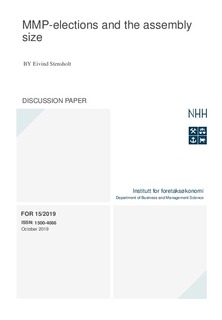| dc.description.abstract | MMP (Mixed Member Proportional) elections for legislatures have ballots with one vote in a local single seat tally and one vote for a party list in a multi-seat tally.
In Germany, the multi-seat tally occasionally violated a Participation axiom. The federal Constitutional Court declared this unconstitutional in 2008. Rules were changed. In 2017, the result was a Bundestag with 709 members, 111 of them in extra-ordinary party seats.
The paper considers two remedies against excessive assembly size. One is “faithful accounting” of ballot data in each local tally, another a change from Plurality to a Majority method. For this use, we consider IRV, i.e. Instant Runoff Voting, in combination with a 3-candidate Condorcet method. The mayoral IRV election in Burlington 2009 serves as an example, here in the special context of MMP.
Violations of the Participation criterion occur also in the usual Majority methods for single seat elections. The legal adoption of a mathematical axiom from election theory have consequences seen in the context of established impossibility theorems. | nb_NO |
